About Us
Vishwawalking explained
 Ratings Explained
Ratings ExplainedVishwawalks
Day walks
Food
Funky Places
Future walks
Gear
Get Lost
Good reads
Links
Right to Ramble
Site map
Contact us

Wallpaper, which shows on various walls throughout the interior.
Vishwawalking
Ernestown Railway Station
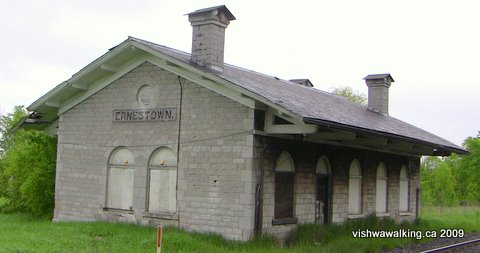 Note:
there is no walk associated with this site.
Note:
there is no walk associated with this site.Ernestown railway station today is steadily declining. The interior is typical of an abandoned building: drywall sagging or punched in, rubble on the floor, toilets and water pipes ripped from the wall, the occasional hole in the floor, etc.
The solid stone exterior still holds some beauty, despite the boarded windows and doors.
Ernestown train station, looking northeast. Note the three stacks. There were
originally four.
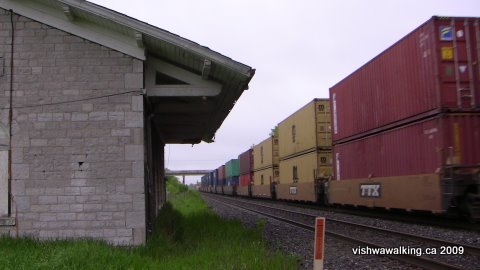 The
station sits on the north side of two sets of still-active tracks, just
west of Lennox and Addington County Road #4, near a little sideroad
called Link Road. It was built
for the Grand Trunk Railway Company of Canada.
Its cornerstone was laid in 1855.
The
station sits on the north side of two sets of still-active tracks, just
west of Lennox and Addington County Road #4, near a little sideroad
called Link Road. It was built
for the Grand Trunk Railway Company of Canada.
Its cornerstone was laid in 1855.In 1852, the Canadian government announced the building of a railway between Montreal and Toronto. The GTR was created in the same year. Shortly thereafter it brought five existing companies into its fold.
The station sits very close to
the tracks. This is because of the doubletracking
which occurred between 1887 and 1903. Above, a train passes on the south
track farthest from the station. A train on the north track comes very close to
the roof of the station.
which occurred between 1887 and 1903. Above, a train passes on the south
track farthest from the station. A train on the north track comes very close to
the roof of the station.
In 1853 it began building the line between Montreal and Toronto, finishing it in 1856.
But the company was growing too fast. Despite being pulled from bankruptcy by the government in 1861, it eventually succumbed. Much like car companies today, only government welfare and amalgamations allowed it to continue to function. The GTR was allowed the flourish, but so did government debt.
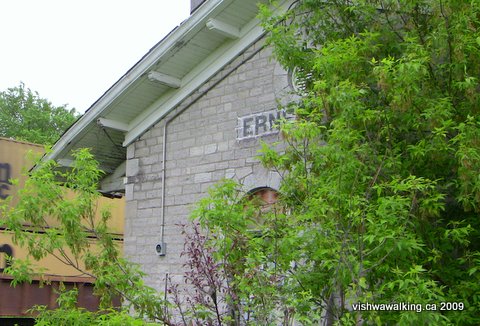 The
GTR dug its own grave for several reasons. First it refused to link
with the Montreal docks, where there may have been a cooperative way to
transport grain and other products. Second, it built rails in areas
where there was already service. The competitive nature of capitalism
seems to doom otherwise sensible travel and transportation systems; the
GTR is a fine example of this. Nevertheless, again with lots of
present-day comparisons, a few people made some good bucks before the
government had to pick up the pieces.
The
GTR dug its own grave for several reasons. First it refused to link
with the Montreal docks, where there may have been a cooperative way to
transport grain and other products. Second, it built rails in areas
where there was already service. The competitive nature of capitalism
seems to doom otherwise sensible travel and transportation systems; the
GTR is a fine example of this. Nevertheless, again with lots of
present-day comparisons, a few people made some good bucks before the
government had to pick up the pieces. The east end of the station. Half of this side and the back of the station are
overgrown with shrub trees and bushes.
In 1919 private ownership failed and the company filed for bankruptcy. The government took it over and amalgamated it with Canadian National Railways, which eventually became Canadian National.
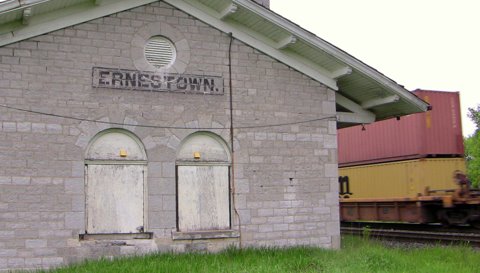 It
has been suggested that political factors were the reason the Ernestown
station was preferred over more populated areas like Bath to the east.
Unlike Bath, there was no real community in Ernestown.
It
has been suggested that political factors were the reason the Ernestown
station was preferred over more populated areas like Bath to the east.
Unlike Bath, there was no real community in Ernestown.After the station was built, a community developed. At the same time, Bath, without a station, declined. Today, with the station abandoned, there are only residences left near the station and no real community.
The
west side of the station. The two windows and the five front windows
were
originally bays, with the sills and lower stonework added at a later date.
originally bays, with the sills and lower stonework added at a later date.
The area was named Ernestown in 1784 after Prince Ernest Augustus, the fourth son of the English king George III. (Some references in web information are made to Ernestown Township, in which Ernestown the hamlet was located. In 1998, under pressure from a Conservative provincial government, the township was amalgamated with Amherst Island and Bath to become the present Loyalist Township.)
When it did operate, Ernestown developed into a centre for shipping livestock.
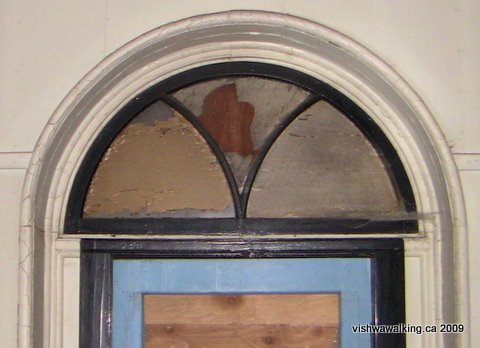 The
design of the station was used in about 34 different stations in
Ontario
in 1855-56, as well as several in the United States. Only the stone
station has survived; there is no sign of
the a freight shed,
loading platform wood shed, dwelling house, and barn which once graced
the property.
The
design of the station was used in about 34 different stations in
Ontario
in 1855-56, as well as several in the United States. Only the stone
station has survived; there is no sign of
the a freight shed,
loading platform wood shed, dwelling house, and barn which once graced
the property.The building is dwarfed today by its surroundings: two active tracks nearby, the road overpass to the east and trees and bushes that obscure the east side and the rear. It's hard to imagine how it could be refurbished, but it is apparently a fine example of the particular "Italianate" style popular in the day.
While the inside has been trashed, the stone outer part stands solid. Hopefully somebody will find a use for it and the building can be loved again.
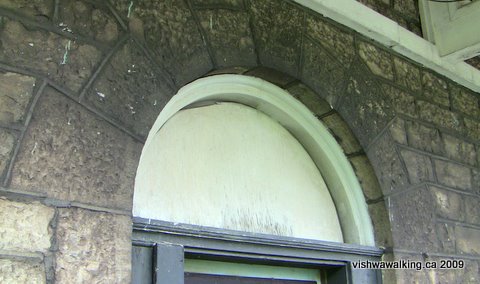 In
1992, the site was designated by the Canadian government as a Heritage
Railway Station. This means that "changes" cannot be made to the
building; unfortunately Nature (and regarding the inside, some yahoos)
haven't read the regulations.
In
1992, the site was designated by the Canadian government as a Heritage
Railway Station. This means that "changes" cannot be made to the
building; unfortunately Nature (and regarding the inside, some yahoos)
haven't read the regulations.I'm not sure when the building ceased being used by passengers and freight. It was referred to as being used "occasionally" by railway people for storage in the early 1990s, but now sits unused.
The outside front arch over the
door at the front of the station.
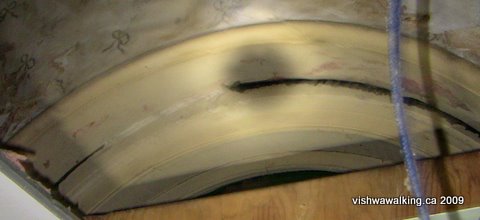
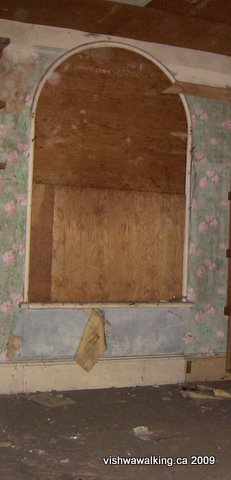

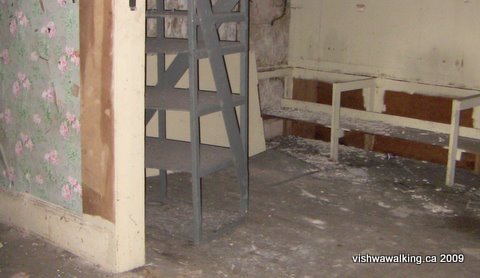
Top left: a glimpse of an inside arch with some of the old molding.
Top right: a boarded-up window, inside. Note that the baseboard changes under the window, indicating the switch from a full open bay to windows with sills, as mentioned above.
Middle left: destruction of facilities inside the building.
Bottom left: a bit of the inside. It's pretty ordinary. Note the different wallpaper.

Above: looking westward. The eastern wall has a (boarded-up) door in it.
Much of the above information was gleaned from CNR in Ontario; Railway Station Reports. This is a page well worth checking for more detailed information on the Ernestown station. It has great information on other stations as well.
Back to the main Get Lost page.
Back to the Abandoned Buildings page.
Back to the top of this page
Home | Contact Us | Site Map
Visited:
May 27, 2009
Page created: May 28, 2009
Page created: May 28, 2009